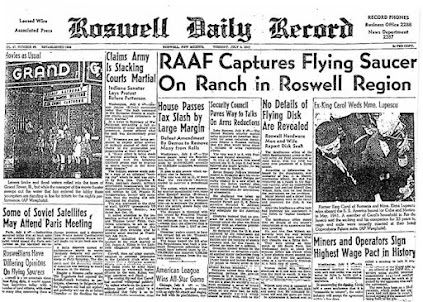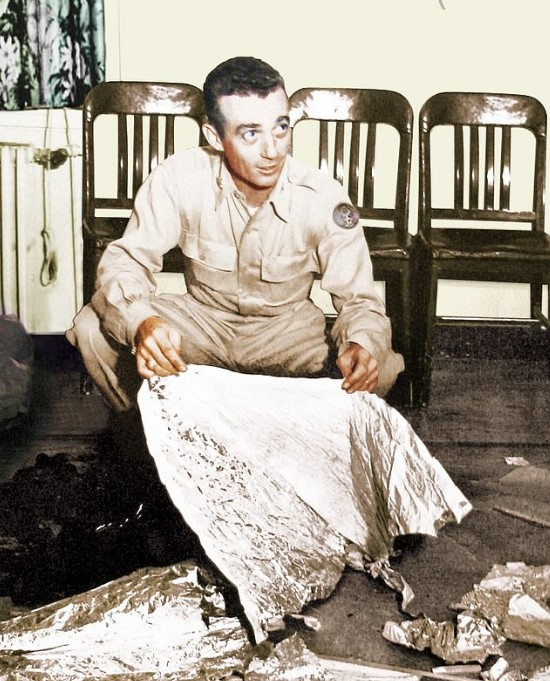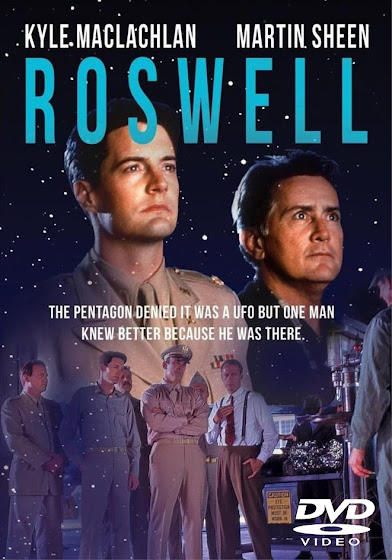Case: Roswell UFO Crash and Retrieval
Timeline: July, 1947
Location: Roswell, NM
Map: Google UFO Map Google Earth Map Google Map
Type: CE3
Classification: CE5 (see about classification)
Source: UFOEvidence.org, Wikipedia.org, Mufom.org
Synopsis: In early July 1947 an incident occurred in the desert just outside of Roswell, NM. Many people have heard of the Roswell UFO crash, but very few people know the details of the incident. The following account of the 1947 UFO incident was taken from public records, from information provided by the International UFO Museum, The Mufon Website and from the press release for UFO Encounter 1997.
 LTC Jesse Antoine Marcel Sr. (Colorized & Edited Credit UFO Timeline Project)[/caption]
LTC Jesse Antoine Marcel Sr. (Colorized & Edited Credit UFO Timeline Project)[/caption]
LTC Jesse Antoine Marcel Sr. - Colorized
Original Interpretation:
On July 8, 1947, the Roswell Army Air Field (RAAF) public information officer Walter Haut, issued a press release stating that personnel from the field's 509th Operations Group had recovered a "flying disk", which had crashed on a ranch near Roswell. Later that day, the press reported that Commanding General of the Eighth Air Force Roger Ramey had stated that a weather balloon was recovered by the RAAF personnel. A press conference was held, featuring debris (foil, rubber and wood) said to be from the crashed object, which seemed to confirm its description as a weather balloon.
Subsequently the incident faded from the attention of UFO researchers for over 30 years. In 1978, physicist and ufologist Stanton T. Friedman interviewed Major Jesse Marcel who was involved with the original recovery of the debris in 1947. Marcel expressed his belief that the military covered up the recovery of an alien spacecraft. His story spread through UFO circles, being featured in some UFO documentaries at the time. In February 1980, the National Enquirer ran its own interview with Marcel, garnering national and worldwide attention for the Roswell incident. Additional witnesses added significant new details, including claims of a large-scale military operation dedicated to recovering alien craft and aliens themselves, at as many as 11 crash sites, and alleged witness intimidation. In 1989, former mortician Glenn Dennis put forth a detailed personal account, wherein he claimed alien autopsies were carried out at the Roswell base.
In response to these reports, and after United States congressional inquiries, the General Accounting Office launched an inquiry and directed the Office of the United States Secretary of the Air Force to conduct an internal investigation. The result was summarized in two reports. The first, released in 1995, concluded that the reported recovered material in 1947 was likely debris from Project Mogul. The second report, released in 1997, concluded reports of recovered alien bodies were likely a combination of innocently transformed memories of military accidents involving injured or killed personnel, innocently transformed memories of the recovery of anthropomorphic dummies in military programs like Operation High Dive conducted in the 1950s, and hoaxes perpetrated by various witnesses and UFO proponents. The psychological effects of time compression and confusion about when events occurred explained the discrepancy with the years in question. These reports were dismissed by UFO proponents as being either disinformation or simply implausible. But at the same time, several high-profile UFO researchers discounted the possibility that the incident had anything to do with aliens.
Modern Interpretation:
On June 14, 1947, William Brazel, a foreman working on the Foster homestead, noticed strange clusters of debris approximately 30 miles (50 km) north of Roswell, New Mexico. This date—or "about three weeks" before July 8—appeared in later stories featuring Brazel, but the initial press release from the Roswell Army Air Field (RAAF) said the find was "sometime last week," suggesting Brazel found the debris in early July. Brazel told the Roswell Daily Record that he and his son saw a "large area of bright wreckage made up of rubber strips, tinfoil, a rather tough paper and sticks." He paid little attention to it but returned on July 4 with his son, wife and daughter to gather up the material. Some accounts have described Brazel as having gathered some of the material earlier, rolling it together and stashing it under some brush. The next day, Brazel heard reports about "flying discs" and wondered if that was what he had picked up. On July 7, Brazel saw Sheriff Wilcox and "whispered kinda confidential like" that he may have found a flying disc. Another account quotes Wilcox as saying Brazel reported the object on July 6.
Wilcox called RAAF Major Jesse Marcel and a "man in plainclothes" accompanied Brazel back to the ranch where more pieces were picked up. "[We] spent a couple of hours Monday afternoon [July 7] looking for any more parts of the weather device", said Marcel. "We found a few more patches of tinfoil and rubber."
As described in the July 9, 1947 edition of the Roswell Daily Record,
The balloon which held it up, if that was how it worked, must have been 12 feet long, [Brazel] felt, measuring the distance by the size of the room in which he sat. The rubber was smoky gray in color and scattered over an area about 200 yards in diameter. When the debris was gathered up, the tinfoil, paper, tape, and sticks made a bundle about three feet long and 7 or 8 inches thick, while the rubber made a bundle about 18 or 20 inches long and about 8 inches thick. In all, he estimated, the entire lot would have weighed maybe five pounds. There was no sign of any metal in the area which might have been used for an engine, and no sign of any propellers of any kind, although at least one paper fin had been glued onto some of the tinfoil. There were no words to be found anywhere on the instrument, although there were letters on some of the parts. Considerable Scotch tape and some tape with flowers printed upon it had been used in the construction. No strings or wires were to be found but there were some eyelets in the paper to indicate that some sort of attachment may have been used.
A telex sent to an Federal Bureau of Investigation (FBI) office from the Fort Worth, Texas office quoted a Major from the Eighth Air Force (also based in Fort Worth at Carswell Air Force Base) on July 8, 1947 as saying that "The disc is hexagonal in shape and was suspended from a balloon by cable, which balloon was approximately twenty feet in diameter. Major Curtan further advices that the object found resembles a high altitude weather balloon with a radar reflector, but that telephonic conversation between their office and Wright field had not [UNINTELLIGIBLE] borne out this belief."
A National Oceanic and Atmospheric Administration(NOAA) weather balloon after launching
Early on Tuesday, July 8, the RAAF issued a press release, which was immediately picked up by numerous news outlets:
The many rumors regarding the flying disc became a reality yesterday when the intelligence office of the 509th Bomb group of the Eighth Air Force, Roswell Army Air Field, was fortunate enough to gain possession of a disc through the cooperation of one of the local ranchers and the sheriff's office of Chaves County. The flying object landed on a ranch near Roswell sometime last week. Not having phone facilities, the rancher stored the disc until such time as he was able to contact the sheriff's office, who in turn notified Maj. Jesse A. Marcel of the 509th Bomb Group Intelligence Office. Action was immediately taken and the disc was picked up at the rancher's home. It was inspected at the Roswell Army Air Field and subsequently loaned by Major Marcel to higher headquarters.
Colonel William H. Blanchard, commanding officer of the 509th, contacted General Roger M. Ramey of the Eighth Air Force in Fort Worth, Texas, and Ramey ordered the object be flown to Fort Worth Army Air Field. At the base, Warrant Officer Irving Newton confirmed Ramey’s preliminary opinion, identifying the object as being a weather balloon and its "kite," a nickname for a radar reflector used to track the balloons from the ground. Another news release was issued, this time from the Fort Worth base, describing the object as being a "weather balloon".
Photos:

Roswell News Release Article

LTC Jesse Antoine Marcel Sr. - Colorized - Following orders to cover the truth.
Videos:
First revealed on 1970s TV Show "In Search Of"
The Movie: Roswell: The U.F.O. Cover-Up (1994)
The Movie Poster:

Map:
FAIR USE NOTICE: This page may contain copyrighted material the use of which has not been spe
Case: Roswell UFO Crash and Retrieval
Timeline: July, 1947
Location: Roswell, NM
Map: Google UFO Map Google Earth Map Google Map
Type: CE3
Classification: CE5 (see about classification)
Source: UFOEvidence.org, Wikipedia.org, Mufom.org
Synopsis: In early July 1947 an incident occurred in the desert just outside of Roswell, NM. Many people have heard of the Roswell UFO crash, but very few people know the details of the incident. The following account of the 1947 UFO incident was taken from public records, from information provided by the International UFO Museum, The Mufon Website and from the press release for UFO Encounter 1997.
 LTC Jesse Antoine Marcel Sr. (Colorized & Edited Credit UFO Timeline Project)[/caption]
LTC Jesse Antoine Marcel Sr. (Colorized & Edited Credit UFO Timeline Project)[/caption]
LTC Jesse Antoine Marcel Sr. - Colorized
Original Interpretation:
On July 8, 1947, the Roswell Army Air Field (RAAF) public information officer Walter Haut, issued a press release stating that personnel from the field's 509th Operations Group had recovered a "flying disk", which had crashed on a ranch near Roswell. Later that day, the press reported that Commanding General of the Eighth Air Force Roger Ramey had stated that a weather balloon was recovered by the RAAF personnel. A press conference was held, featuring debris (foil, rubber and wood) said to be from the crashed object, which seemed to confirm its description as a weather balloon.
Subsequently the incident faded from the attention of UFO researchers for over 30 years. In 1978, physicist and ufologist Stanton T. Friedman interviewed Major Jesse Marcel who was involved with the original recovery of the debris in 1947. Marcel expressed his belief that the military covered up the recovery of an alien spacecraft. His story spread through UFO circles, being featured in some UFO documentaries at the time. In February 1980, the National Enquirer ran its own interview with Marcel, garnering national and worldwide attention for the Roswell incident. Additional witnesses added significant new details, including claims of a large-scale military operation dedicated to recovering alien craft and aliens themselves, at as many as 11 crash sites, and alleged witness intimidation. In 1989, former mortician Glenn Dennis put forth a detailed personal account, wherein he claimed alien autopsies were carried out at the Roswell base.
In response to these reports, and after United States congressional inquiries, the General Accounting Office launched an inquiry and directed the Office of the United States Secretary of the Air Force to conduct an internal investigation. The result was summarized in two reports. The first, released in 1995, concluded that the reported recovered material in 1947 was likely debris from Project Mogul. The second report, released in 1997, concluded reports of recovered alien bodies were likely a combination of innocently transformed memories of military accidents involving injured or killed personnel, innocently transformed memories of the recovery of anthropomorphic dummies in military programs like Operation High Dive conducted in the 1950s, and hoaxes perpetrated by various witnesses and UFO proponents. The psychological effects of time compression and confusion about when events occurred explained the discrepancy with the years in question. These reports were dismissed by UFO proponents as being either disinformation or simply implausible. But at the same time, several high-profile UFO researchers discounted the possibility that the incident had anything to do with aliens.
Modern Interpretation:
On June 14, 1947, William Brazel, a foreman working on the Foster homestead, noticed strange clusters of debris approximately 30 miles (50 km) north of Roswell, New Mexico. This date—or "about three weeks" before July 8—appeared in later stories featuring Brazel, but the initial press release from the Roswell Army Air Field (RAAF) said the find was "sometime last week," suggesting Brazel found the debris in early July. Brazel told the Roswell Daily Record that he and his son saw a "large area of bright wreckage made up of rubber strips, tinfoil, a rather tough paper and sticks." He paid little attention to it but returned on July 4 with his son, wife and daughter to gather up the material. Some accounts have described Brazel as having gathered some of the material earlier, rolling it together and stashing it under some brush. The next day, Brazel heard reports about "flying discs" and wondered if that was what he had picked up. On July 7, Brazel saw Sheriff Wilcox and "whispered kinda confidential like" that he may have found a flying disc. Another account quotes Wilcox as saying Brazel reported the object on July 6.
Wilcox called RAAF Major Jesse Marcel and a "man in plainclothes" accompanied Brazel back to the ranch where more pieces were picked up. "[We] spent a couple of hours Monday afternoon [July 7] looking for any more parts of the weather device", said Marcel. "We found a few more patches of tinfoil and rubber."
As described in the July 9, 1947 edition of the Roswell Daily Record,
The balloon which held it up, if that was how it worked, must have been 12 feet long, [Brazel] felt, measuring the distance by the size of the room in which he sat. The rubber was smoky gray in color and scattered over an area about 200 yards in diameter. When the debris was gathered up, the tinfoil, paper, tape, and sticks made a bundle about three feet long and 7 or 8 inches thick, while the rubber made a bundle about 18 or 20 inches long and about 8 inches thick. In all, he estimated, the entire lot would have weighed maybe five pounds. There was no sign of any metal in the area which might have been used for an engine, and no sign of any propellers of any kind, although at least one paper fin had been glued onto some of the tinfoil. There were no words to be found anywhere on the instrument, although there were letters on some of the parts. Considerable Scotch tape and some tape with flowers printed upon it had been used in the construction. No strings or wires were to be found but there were some eyelets in the paper to indicate that some sort of attachment may have been used.
A telex sent to an Federal Bureau of Investigation (FBI) office from the Fort Worth, Texas office quoted a Major from the Eighth Air Force (also based in Fort Worth at Carswell Air Force Base) on July 8, 1947 as saying that "The disc is hexagonal in shape and was suspended from a balloon by cable, which balloon was approximately twenty feet in diameter. Major Curtan further advices that the object found resembles a high altitude weather balloon with a radar reflector, but that telephonic conversation between their office and Wright field had not [UNINTELLIGIBLE] borne out this belief."
A National Oceanic and Atmospheric Administration(NOAA) weather balloon after launching
Early on Tuesday, July 8, the RAAF issued a press release, which was immediately picked up by numerous news outlets:
The many rumors regarding the flying disc became a reality yesterday when the intelligence office of the 509th Bomb group of the Eighth Air Force, Roswell Army Air Field, was fortunate enough to gain possession of a disc through the cooperation of one of the local ranchers and the sheriff's office of Chaves County. The flying object landed on a ranch near Roswell sometime last week. Not having phone facilities, the rancher stored the disc until such time as he was able to contact the sheriff's office, who in turn notified Maj. Jesse A. Marcel of the 509th Bomb Group Intelligence Office. Action was immediately taken and the disc was picked up at the rancher's home. It was inspected at the Roswell Army Air Field and subsequently loaned by Major Marcel to higher headquarters.
Colonel William H. Blanchard, commanding officer of the 509th, contacted General Roger M. Ramey of the Eighth Air Force in Fort Worth, Texas, and Ramey ordered the object be flown to Fort Worth Army Air Field. At the base, Warrant Officer Irving Newton confirmed Ramey’s preliminary opinion, identifying the object as being a weather balloon and its "kite," a nickname for a radar reflector used to track the balloons from the ground. Another news release was issued, this time from the Fort Worth base, describing the object as being a "weather balloon".
Photos:

Roswell News Release Article

LTC Jesse Antoine Marcel Sr. - Colorized - Following orders to cover the truth.
Videos:
First revealed on 1970s TV Show "In Search Of"
The Movie: Roswell: The U.F.O. Cover-Up (1994)
The Movie Poster:

Map:
FAIR USE NOTICE: This page may contain copyrighted material the use of which has not been spe